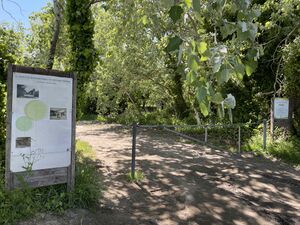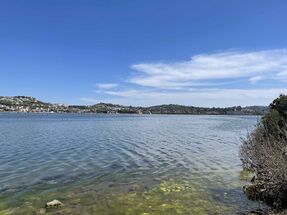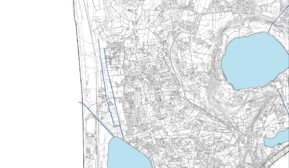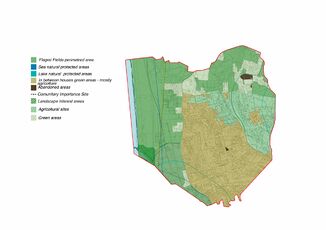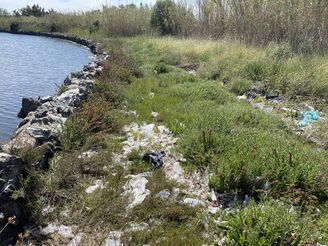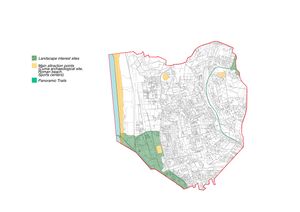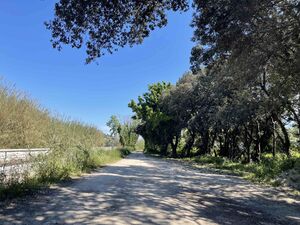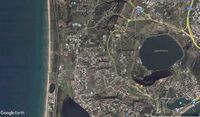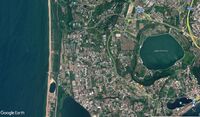Quarantena Park WAVE Living Lab 2022: Difference between revisions
| Line 76: | Line 76: | ||
*''add 1-2 graphical representations to the image gallery, you can add more if you like'' | *''add 1-2 graphical representations to the image gallery, you can add more if you like'' | ||
<gallery widths="200" heights="150" perrow="5"> | |||
An important characteristic of this land are definally the bathing establishment along the coast cross the quarantena park, in the nothen part it is not quite known. The area is also | |||
characteristic by the strong presence of housing, there are also some schools and many fields, but it is not an area that has been lived bu the inhabitans. | |||
About the historical evolution, there are not been many changes in the last 10 years because the majority of the area has been buit in the early 80s, and there should not be more construction in this area because it can roun its characteristic of being an agricolural town. Many people who live in Bacoli had bought a piece of land in this area even tho they live somewhere else around the town.<gallery widths="200" heights="150" perrow="5"> | |||
File:Quarantena Park 2004.jpg|Historical evolution of the study area from 2004 to 2021. ''(2004)'' | File:Quarantena Park 2004.jpg|Historical evolution of the study area from 2004 to 2021. ''(2004)'' | ||
File:Quarantena Park 2009.jpg|''2009'' | File:Quarantena Park 2009.jpg|''2009'' | ||
Revision as of 16:32, 18 May 2022
>>>back to working groups overview
| Area | Quarantena park | |
| Place | Bacoli | |
| Country | Italy | |
| Topics | lake, park, archeological site and the beach | |
| Author(s) | Giulia Di Biase, Carmen De Filippo, Kelly Chiara Saul, Chiara Castellano | |
Rationale
- Why do you think this case is relevant? What is your hypothesis considering the landscape challenges?
This case is relevant because it belongs in an area that has a lot of history and potential for its natural characteristics. There are lakes, beaches and there are also panoramic walks and remarkable areas that belong to the Flegrei Fields Regional Park. Both the archaeological sites and the natural protected areas are points of interest that need to be promoted through the landscape projects to not destroy their internal eco-systems and to acknowledge their real importance.
Location and scope
Water as a natural system
Geomorphology, typologies and dynamics of water areas
- Describe the water areas of your area in the contxt of the wider water system
The water areas in this area are included into a more wide systems of volcanic lakes that characterizes the Flegrei Fields park. Also, there is a little stretch of coast, identified as Spiaggia Romana. There are no rivers, indeed they're more like small canals that go into the cultivated areas.
- How does water appear in the landscape of your living lab? What types of water areas are common?
In the landscape of the area, water appears as sea and volcanic lakes. It's really common to have beaches and caves, some dunes before you arrive to the beach and cliffs in certain points of the coast line. Also there are cultivated fields served by canals that drain the water from the lakes.
- Please identify the water bodies' catchment areas, tributaries and floodplains
- Which dynamics do these water areas have?
- Have there been any flood events in the past?
There are no flood events recorded in recents years for this specific area, but there have been some flood episodes in the area of the fusaro lake that overlooks via giulio cesare. Mainly of the problems are due to the lack of maintenance of the road surface and drainage for rainwater which does not allow to open waterways towards the mouth and the lake
Water as a living space
- Which habitats can be found in and along the water areas of your area? Along the sea in the area there are agricolture fields, fruit trees and some natural spaces that have no function. The quarantena park near the lake Fusaro and the dunes near the beach side. The area is mostly residential, so also we have a system of single houses with gardens. There aren't a lot of animal species, except for the breeding ones, fishes and some animals that are in the quarantena park for the visitors to see like farm animals, horses and dogs.
- How is the water quality in your water areas? It's largely polluted, for the industrial discharges. Also the lake side is full of garbage, mostly plastic that goes in the water.
- Which areas are still natural, which are urbanized/artificial? Mostly, the areas on the direction of the beach are natural because they are protected sites. We have a density of construction going on the direction of the Averno lake, but they are surrounded by green spaces (often with no function or private gardens) and by agricolture spaces, that are the main characteristic of the area. (see the focus map for a clear representation of the different green spaces use).
Blue and Green Infrastructure
- What are the major potential elements of a green/blue infrastructure network? Are these likely to change/disappear? Why is that?
The main elements of the blue infrastructure are the Fusaro lake, which is located in the lower part of our area, and the coast with the Roman beach, which is located at the slopes of the promontory of Cuma. The Fusaro lake and the sea are connected by the mounth of the lake, which divides the Quarantine Park and the agricultural area. The main elements of the green infrastructure are the Quarantine park, which covers the total length of the left side of Fusaro lake. The tracks of the Curcumflegrea divide the green area in two part, on the left the abandoned part and on the right the agricultural area. North-west of our area is the promontory of Cuma, the regional forest and the archaeological site of Cuma. Throughout the area there is a strong presence of agricoltural areas, in which there are also many greenhouses.
Water as a cultural space
Land use and water
- map the land uses along your water areas: settlements, infrastructure, agriculture, resource extraction, natural areas, energy production...
- describe in particular the historical evolution of land use pattern, please make use of historical maps
- description evolution, status quo and driving forces, is the land use likely to change? Why is that? (approx 200 signs)
- add 1-2 graphical representations to the image gallery, you can add more if you like
An important characteristic of this land are definally the bathing establishment along the coast cross the quarantena park, in the nothen part it is not quite known. The area is also
characteristic by the strong presence of housing, there are also some schools and many fields, but it is not an area that has been lived bu the inhabitans.
About the historical evolution, there are not been many changes in the last 10 years because the majority of the area has been buit in the early 80s, and there should not be more construction in this area because it can roun its characteristic of being an agricolural town. Many people who live in Bacoli had bought a piece of land in this area even tho they live somewhere else around the town.
Cultural and spatial typologies of water areas
- Which spatial patterns have evolved in relation to your water areas?
- What is the role of water areas within the overall urban morphology? (approx 200 signs)
- add 1-2 graphical representations to the image gallery, you can add more if you like
- Yourcase water space1.jpg
add a caption
- Yourcase water space2.jpg
add a caption
- Yourcase water space3.jpg
add a caption
Sacred spaces and heritage
- Which places/elements hold cultural value and to whom?
There are several places with this characteristic within the area, but currenty they are not valued and are in state of neglect.
- You may add a map and some images, please also explain in your caption why these elements are valuable
- Your case sacredspace1.jpg
add a caption
- Your case sacredspace2.jpg
add a caption
- Your case sacredspace3.jpg
add a caption
Visual appearance and landscape narrative
- Which elements are essential for the landscape character?
- Has the landscape been painted or otherwise depicted, when and whom? Which elements are essential?
- Which narratives exist? Who has written about this landscape or depicted it in some way?
- You can add text and images
- Your case character1.jpg
add a caption
- Your case character2.jpg
add a caption
- Your case character3.jpg
add a caption
Water and People
Accessibility and usability
- Where are your water areas accessible, and where not? How strong are spatial obstacles preventing access?
- Who is using the spaces and how?
- Yourcase youraccessbilitymap.jpg
add a caption
- Yourcase usepatterns.jpg
add a caption
Community Mapping
What is to be mapped here?
- Social groups from within the community, for example the youth, kids, students, parents, the retired etc. Typically, these groups have specific needs, which you can also make explicit on the map. These people might not be organized in any way, but they are usually present in the context you are observing
- Local stakeholder groups: these groups are organized in one or the other way. They only exist within the community context you are observing. For example: the local community center, local churches, local interest groups, the landowners, small businesses and retailers
- External stakeholder groups are not necessarily present in the environment you are observing, but they may have strong stakes and interests. These can be local authorities, politicians, associations, care services etc.
- For each group, you may identify their needs, objectives, power and capacities
- You may also identify gaps and power conflicts
- Please try to redepict these elements in an integrated way and in relation to your water landscape. What is the relationship between these groups? Are they close or distanced from each other? Who is more powerful? Which voices are hardly heard? Do they have any shared concerns?
- Your case your community map1.jpg
add a caption
- Your case your community map2.jpg
add a caption
- Your case your community map3.jpg
add a caption
Possible Futures
- You can summarize your findings with a SWOT diagram and a DPSI(R) Model
- Link back to the Sustainable Development Goals: Which goals are at risk?
- What is your worst case scenario for this landscape?
- What is your best case scenario for this landscape?
- Present your scenarios in the form of a collage or sketch
- Add text and visuals
- Your case your spider diagram or dpsir model.jpg
explain your analysis briefly in the caption
- Your case yourworstcase visual.jpg
explain your worst case scenario briefly in the caption
- Your case yourbestcase visual.jpg
explain your best case scenario briefly in the caption
Collaborative Goal Setting
- Define strategic planning objectives based on the evaluation findings from your analysis
- Ideally, involve the community of your living labs into this process
- Link back to your original targets from section one and the Development Goals
- 150 words text contribution
Spatial Strategy and Transect
- translate your strategic goals into a vision
- develop a spatial translation of your vision
- exemplify your vision in the form of a transect with concrete interventions
- add map(s) and visualizations
- Your case spatial translaton vision.jpg
add caption here
- Your case transect.jpg
add caption here
- Your case transect detail1.jpg
add caption here
- Your case transect detail2.jpg
add caption here
From Theory of Change to Implementation
- For implementing your vision: Which partnerships are needed? Which governance model is required?
- Who needs to act and how? Draw and explain a change/process model/timeline
- Which resources are needed? On which assets can you build?
- add 150 words text and visuals
References
- give a full list of the references you have used for your case
Process Reflection
- Reflect in your intercultural and interdisciplinary team on the outcomes of your study
- Which limitations were you facing?
- What have you learnt from each other?
- What did you learn in the Living Labs?
- What would you do differently next time?
- You can also use diagrams/visuals
- 250 words text
